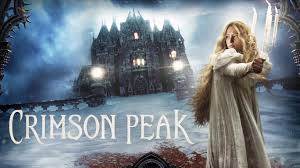Film review: Crimson Puck is a horror all right

Guillermo del Toro’s Gothic romance is visually ravishing. But though it’s ‘a banquet for the eyes, it’s a meagre snack in every other respect,’ writes critic Nicholas Barber.
By Nicholas Barber
15 October 2015
Guillermo del Toro could have saved himself a lot of time and trouble if, instead of making Crimson Peak, he’d posted a tweet, saying, ‘I really like Victorian Gothic movies set in spooky old houses’. His new film, which should have been a Halloween treat, is his loving tribute to Rebecca, Jane Eyre and Great Expectations, as well as the Hammer canon, The Rocky Horror Picture Show, and Carry On Screaming. But it’s only a tribute in the sense that it does what all those other films have already done, except not as well.
Yes, there are family secrets hidden in cobwebbed rooms, and a soundtrack which consists largely of creaking doors and howling winds, but del Toro doesn’t bring anything personal or novel to the genre except some explicit gore and some computer-generated ghosts. Nor does he imbue it with the strangeness and sadness that made his Spanish-language chillers, The Devil’s Backbone and Pan’s Labyrinth, so spine-tingling. Crimson Peak is a lavish but hollow pastiche that could be mistaken for a horror-themed fairground ride, or one of Disney’s live-action fairy-tale films, or Tim Burton’s Dark Shadows, minus the jokes.
It opens in Buffalo, New York, in 1901. Its heroine, who gets her surname from one of Hammer’s great stars, is Edith Cushing (Mia Wasikowska), the virginal daughter of a widowed industrialist. She is also an aspiring novelist, but considering that her literary ambitions have almost no impact on the story, that’s barely worth mentioning. On a similar note, her handsome but bland suitor, Alan (Charlie Hunnam), collects photographs of ghosts, but it’s a hobby which is introduced and then never referred to again. Edith and Alan seem destined to settle down together, but her head is turned by two new arrivals from England, the dashing Sir Thomas Sharpe (Tom Hiddleston) and his sneering sister Lucille (Jessica Chastain, whose English accent isn’t much better than Hunnam’s American one). Edith’s father suspects that these aristocratic visitors are up to no good, partly because Sir Thomas is so open about being desperate for money, and partly because Lucille has modelled herself on Cruella de Vil. Indeed, it’s so obvious that the siblings are villains that it’s tempting to assume that it’s all a ruse: surely, you think, the Sharpes will ultimately be revealed to be misunderstood heroes. But no. Crimson Peak is one of the rare mystery films in which everyone is exactly as they seem, and everyone’s initial suspicions turn out to be dead right.
Rather than exaggerating the perversities and ironies of Jane Eyre et al, del Toro has toned them down
Still, Edith is naive enough to be fooled. When her father dies suddenly (his forehead is bashed repeatedly against a washbasin, so naturally the authorities conclude that it was an accident), she marries Sir Thomas and moves with him and Lucille to their dilapidated mansion, deep in the English countryside. Like everything else in Crimson Peak, the mansion is gorgeous. The production designer, Thomas E Sanders, has fashioned a fabulously ornate jewel box, cramming the decor of a cathedral into a Hogwarts common room.
And if the man-made decorations weren’t enough, the house’s drastic disrepair makes it even more spellbinding. Leaves flutter prettily down from a hole in the roof and into the grand hall. Ketchup-like sludge from the family’s clay mine oozes up between the floorboards. To complete the visual feast, Wasikowska and Chastain look so magnificent in their sumptuous gowns that they could have stepped out of a Rossetti painting.
Bad romance
As long as you’re gawping at the mansion and its inhabitants, you can see why Crimson Peak exists. You can appreciate that del Toro wanted to take the haunted-house movie and make it bigger, more beautiful and more luxuriant than ever before. But if the film he has served up is a banquet for the eyes, it’s a meagre snack in every other respect. There aren’t enough plot twists. There isn’t enough plot, full stop. Rather than exaggerating the perversities and ironies of Jane Eyre et al, del Toro has toned them down.
She must have been relieved whenever a CGI ghost materialised to break the monotony
The film is nearly halfway through before it moves from the United States to England, and once it’s there, very little happens. With nothing to do and nobody to talk to, Edith is left to wander aimlessly around the house until she eventually solves a riddle which everyone else, including her father, had worked out an hour earlier. She must have been relieved whenever a CGI ghost materialised to break the monotony.
Crimson Peak does include one legitimate puzzle, however, and that’s this one: why doesn’t it have a crimson peak in it? Apparently, the title derives from the locals’ nickname for the Sharpe estate, because its clay-rich soil stains the snow blood-red in winter. The bizarre thing is, though, that this creepy phenomenon occurs on a broad expanse of flat ground. There’s not a peak in sight. Were the locals being sarcastic? If the estate had been nicknamed Crimson Trough, it would have been at least as accurate. The film is more of a trough than a peak, too.
Политика конфиденциальности | Правила пользования сайтом







